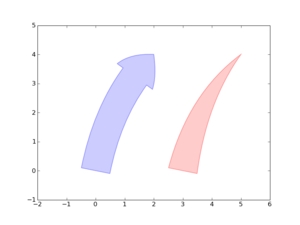Hello,
I'm working on the fancy annotation thing I mentioned the other day,
and I want to have some feedback and advice.
As you see (http://dl.getdropbox.com/u/178748/test_fancy_annotation.jpg),
the annotation will be consist of a fancy box + fancy arrow. And my
current plan is to put the fancy arrow things as an arrow patch class
in the patches.py. The new class would be very similar to the
FancyBboxPatch class. It will take three control points of quadratic
bezier path as an input, and will draw an arrow around this path (an
example is attached). For example
mypatch = YAFancyArrowPatch([(cx0, cy0), (cx1, cy1), (cx2, cy2)],
arrowstyle="simple",
ec="blue!50!white",
fc="blue!20!white")
But, patches.py already has three arrow classes.
* Arrow(x, y, dx, dy)
* FancyArrow(x, y, dx, dy)
* YAArrow(figure, xytip, xybase)
And I'm a bit hesitating in adding yet another arrow class. One way
I'm considering is to merge my arrow class with the currently existing
FancyArrow class (or other). But their interface is a bit different
and I'm afraid that it may confuse users. So, how others think? Would
it better to simply have a seperate arrow class or to have it merged
into one of the existing arrow classes?
The other thing is, as I said, the annotation is consist of a fancy
box and fancy arrow, which means we need to draw a union of two closed
bezier path. I hoped that the agg package have those kind
functionality but I couldn't find one (if there is, please let me
know). So, I think there are two options.
* Forget the union operation and fake it by modifying the order of
"stroke" and "fill", i.e, stroke the paths of the box and arrow first
then fill each path later (with a same color). The above figure uses
this approach. It would not work if your want a transparent fill
color.
* Or, use an external library.
2geom(http://lib2geom.sourceforge.net/) seems promising, and I
currently have a simple wrapper based on it which does the job (2geom
does provide a python interface but not all of its funtionality are
wrapped yet. So I needed make a few changes).
My inclination is to go with the first option. But since this seems a
bit hackish way to do it, I want to know how others think.
Any comment, suggestion, or advice would be appreciated.
-JJ
